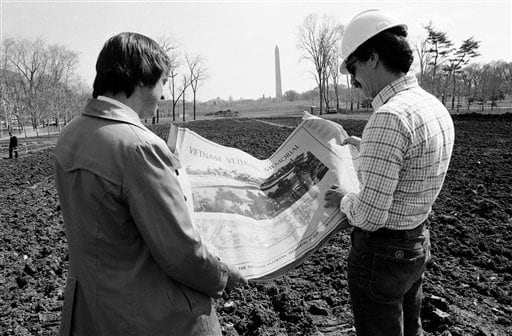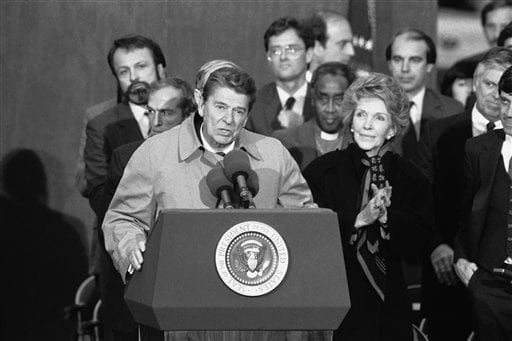Editor's note: The following is a guest commentary.
On Sunday, the Vietnam Veterans Memorial will host a ceremony to commemorate the 35th anniversary of its historic groundbreaking. The idea for a memorial engraved with names of the fallen flowed from my academic research and from testimony before the Senate on what is now called post-traumatic stress, a common reaction to witnessing violence.
The memorial was planned as a societal acknowledgement of those who served, funded by the American people. I started the effort in 1979 while a GS-7 at the Labor Department, thanks to the permission of my wife. This was nonstop work, day after day.
In 1982, the money was in hand, as was a permit to begin construction. The effort barely succeeded. I hope the lessons learned can ease the path to success for a Global War on Terrorism Memorial that will honor a new generation of service members.

Jan Scruggs, left, and project engineer Gary Wright look over plans for the Vietnam Veterans Memorial on March 23, 1982. Groundbreaking took place March 26.
Photo Credit: Bill Auth/AP
For months, the Vietnam Veterans Memorial Fund had been in the middle of a national controversy over the memorial’s design. National media outlets, ranging from The Wall Street Journal to "60 Minutes," were heavily involved.
The affair even ended up at the National Security Council. A staffer at the time was Army Maj. Bob Kimmitt, a supporter of the VVMF. The White House became the key player in keeping an unfriendly interior secretary in check. Politically skilled opponents of the cause held influence in the inner circles of the White House and Interior Department.
Some opponents were determined to stop the groundbreaking despite our agreement to add a statue to the design. I was getting daily advice from some brilliant people, including former Attorney General Elliot Richardson, who told me to "keep the pressure on the White House by using the media to cover their indifference to an effort of such historic significance," and "embarrass the interior secretary with the media".
His advice was sage. I was able to influence the White House with urgent memos to Ed Meese, then-counselor to President Reagan, from the Veterans of Foreign Wars. I met with Time Magazine's Hugh Sidey, whose piece showing the struggle behind the memorial's creation described me as "indefatigable."
It also angered the interior secretary, precisely as planned, setting the stage for victory.
The White House caved. Opponents threatened court action, yet a temporary restraining order was nearly impossible as a legal matter.
On a cold and windy March day, veterans from each of the 50 states broke ground with shovels to show wide support. In the end, it was graduates of West Point whose planning and vision helped me get the job done, especially Kimmitt, John P. Wheeler III and Gen. William Westmoreland. Kimmitt later became ambassador to Germany.
The opposition was led by Naval Academy grads James Webb, retired Vice Adm. James Stockdale and Ross Perot. They viewed the memorial as too modernistic. They had a fair point: A traditional statue was added in 1984, and President Reagan spoke at its dedication ceremony.
(Reagan did not attend either the groundbreaking or the November 1982 dedication. The 1982 controversy raged far beyond the comfort level of his White House advisers.)

President Reagan, with his wife, Nancy, addresses a ceremony at the Vietnam Veterans Memorial on Nov. 12, 1984, in Washington.
Photo Credit: AP photo
Since its construction, the Wall has hosted more than 100 million visitors and is an important symbol to both the nation and the veterans. Could we have built it today? I really doubt it – with social media, "fake news," Facebook, and so on, a few clever tweets would have brought the plans to an end.
THE NEW STRUGGLE
Plans for a new national memorial – one that will honor those who have served since the Sept. 11 attacks – are making progress.
These service members deserve the memorial they are seeking. Warfare continues in places like Syria and Iraq, and likely will continue for many decades.
Civilians have been honored at the National September 11 Memorial and Museum, the Pentagon, and a memorial in Shanksville, Pennsylvania. The veterans have been left out, even as they are under fire today in the Middle East and Afghanistan.
Those veterans are taking action. Leaders of the effort again include service academy grads, such as Andrew Brennan, a former helicopter pilot in Afghanistan and the founder of the Global War on Terror Memorial Foundation. This team will meet the challenges ahead, which are substantial.
Legislation to authorize construction is moving through Congress this year. It made progress last year thanks to then-Rep. Ryan Zinke, R-Mont. – a former Navy SEAL who is now the interior secretary. That is a stroke of luck; perhaps the Trump administration can get behind this effort.
After legislation is complete – some skirmishing in Congress is expected; contact your lawmakers to push for swift passage – work will be done on a site and design. Funding and other tasks should take five years or less.
The goal is to create a place of honor for the veterans of our most recent (and ongoing) wars to gather. It worked 35 years ago with the Vietnam Veterans Memorial. Let's welcome these veterans home with a memorial and a parade down Constitution Avenue.
The time is now. Learn more at www.gwotmemorialfoundation.org
Jan C. Scruggs founded the Vietnam Veterans Memorial Fund and served as the group's president from 1979 to 2015. He's been on the board of advisers for the Global War on Terrorism Memorial since 2015. A native Washingtonian, he's now retired and living in Annapolis, Maryland.




